
Marine Attack Squadron 231 (VMA-231) is a United States Marine Corps fixed wing attack squadron that consists of AV-8B Harrier (V/STOL) jets. The squadron, known as the "Ace of Spades", is based at Marine Corps Air Station Cherry Point, North Carolina and fall under the command of Marine Aircraft Group 14 (MAG-14) and the 2nd Marine Aircraft Wing.

Marine Fighter Attack Squadron 142 (VMFA-142) was an aviation unit of the United States Marine Corps Reserve that was active from 1942 to 2008. At the time of its inactivation, the squadron was based at Naval Air Station Atlanta, Georgia and fell under the command of Marine Aircraft Group 42 (MAG-42), 4th Marine Aircraft Wing. Due to a re-organization within Marine aviation, the squadron moved to Naval Air Station Fort Worth Joint Reserve Base, Texas and was placed in a cadre status under Marine Aircraft Group 41.
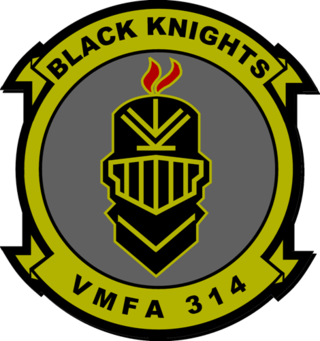
Marine Fighter Attack Squadron 314 (VMFA-314) is a United States Marine Corps F-35C Lightning II squadron. The squadron, known as the "Black Knights", is based at Marine Corps Air Station Miramar, California and falls under the command of Marine Aircraft Group 11 (MAG-11) and the 3rd Marine Aircraft Wing, but deploys with the US Navy's Carrier Air Wing Nine (NG).
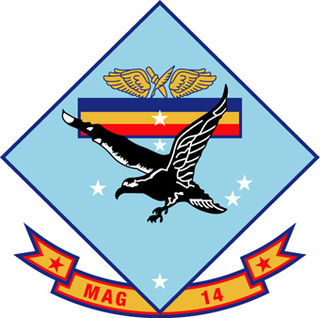
Marine Aircraft Group 14 (MAG-14) is a United States Marine Corps aviation unit based at Marine Corps Air Station Cherry Point, North Carolina that is currently composed of two AV-8B Harrier squadrons, one F-35B squadron, one UAV training squadron, one KC-130 squadron, and an aviation logistics squadron.

Marine Fighter Attack Squadron 312 (VMFA-312) is a United States Marine Corps F/A-18C Hornet squadron. Also known as the "Checkerboards", the squadron is based at Marine Corps Air Station Beaufort, South Carolina and falls under the command of Marine Aircraft Group 31 (MAG-31) and the 2nd Marine Aircraft Wing. The Radio Callsign is "Check."

Marine Aerial Refueler Transport Squadron 234 (VMGR-234) is a reserve United States Marine Corps KC-130J squadron. They are a part of Marine Aircraft Group 41 (MAG-41), 4th Marine Aircraft Wing and provide both fixed-wing and rotary-wing aerial refueling capabilities to support Marine Forces Reserve air operations in addition to assault air transport of personnel, equipment, and supplies. The squadron, known as the "Rangers" is stationed at Naval Air Station Joint Reserve Base Fort Worth, Texas.
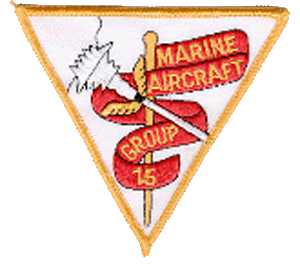
Marine Aircraft Group 15 (MAG-15) was a United States Marine Corps aviation group established during World War II. MAG-15, a transport and photo-reconnaissance training group, was commissioned on 1 March 1942, headquartered at Camp Kearny, San Diego. In addition to radio and photographic training, the Group also conducted a navigation school. Additional roles included West Coast aircraft acceptance and transport service for the Marine Corps.
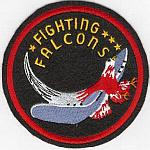
Marine Fighting Squadron 221 (VMF-221) was a reserve fighter squadron of the United States Marine Corps. Originally commissioned during the World War II, it flew the Brewster F2A-3, and after reconstitution in 1943, the F4U Corsair. The squadron, also known as the "Fighting Falcons", is most notable for its actions on 4 June 1942, during the Battle of Midway, which resulted in 23 members of the squadron, many posthumously, being awarded the Navy Cross for their actions in combat. VMF-221 ended World War II with 185 air-to-air victories, the second most of any Marine Fighting Squadron in the war.
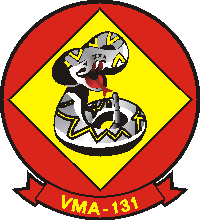
Marine Attack Squadron 131 (VMA-131) was an A-4 Skyhawk attack squadron in the United States Marine Corps. The squadron, also known as the "Diamondbacks", were part of the Marine Forces Reserve and were based at Naval Air Station New York, Brooklyn, New York from 1960 through 1970 and NASJRB Willow Grove from 1971 until their deactivation in 1998.

Marine Aviation Training Support Group 23 (MATSG-23) is a United States Marine Corps aviation training group originally established during World War II as Marine Aircraft Group 23 (MAG-23). Squadrons from MAG-23, augmented by Navy and Army flying units formed the Cactus Air Force during the Battle of Guadalcanal. Since then it has evolved into the first Aviation Logistics focused Colonel level command, and serves as a functional training advocate for all USMC Aviation Logistics entry-level training. The instructors and support staff of MATSG-23 are responsible for training thousands of Marines per year in the disciplines required to enable the expeditionary aviation required to support the Marine Air Ground Task Force.
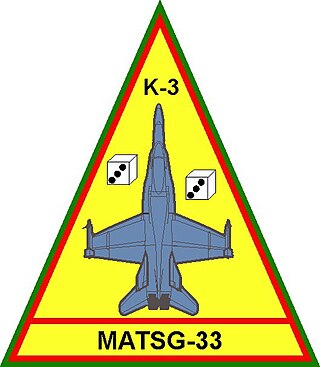
Marine Aviation and Training Support Group 33 (MATSG-33) is a United States Marine Corps aviation training group that was originally established during World War II as Marine Aircraft Group 33 (MAG-33). Fighter squadrons from MAG-33 fought most notably during the Battle of Okinawa and also as the first Marine aviation units to support the Korean War when they arrived as part of the 1st Provisional Marine Brigade. They helped stabilize the United Nations positions during the Battle of Pusan Perimeter and fought in Korea for the remainder of the war. At some point in the 1960s, the group was deactivated and was not reactivated until 2000, when Marine Aviation Training Support Group at Naval Air Station Oceana, Virginia was renamed MATSG-33.

Marine Fighting Squadron 132 (VMF-132) was a fighter squadron in the United States Marine Corps. The squadron, also known as "The Crying Red Asses", fought in World War II as a dive bomber unit during the Battle of Guadalcanal as part of the Cactus Air Force and later fought in the Central Solomon Islands. The squadron was decommissioned shortly after the end of the war but was reactivated in the Marine Air Reserve flying out of Floyd Bennett Field in Brooklyn, New York. They were again decommissioned sometime after 1958.

Marine Attack Squadron 144 (VMA-144) was a reserve Douglas A-4 Skyhawk attack squadron in the United States Marine Corps. Originally known as VMSB-144, the squadron saw its first combat in World War II as part of the Cactus Air Force during the Battle of Guadalcanal and also provided close air support during the Bougainville campaign (1943-1945). Following the war the squadron was deactivated but later became part of the Marine Air Reserve and was based out of Naval Air Station Jacksonville and then Naval Air Station Cecil Field, Florida.
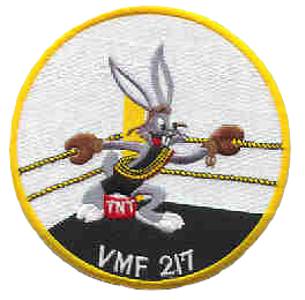
Marine Attack Squadron 217 (VMA-217) was a fighter squadron of the United States Marine Corps that was activated and fought during World War II. Known as "Max’s Wild Hares", they fought in many areas of the Pacific War including the Battle of Iwo Jima. Following the surrender of Japan, the squadron was deactivated on 10 March 1946. They were briefly reactivated as part of the Reserves but were again deactivated in 1964 and remain in an inactive status today.

Marine Attack Squadron 233 (VMA-233) was an A-4 Skyhawk attack squadron in the United States Marine Corps. The squadron, also known as the "Flying Deadheads", were part of the Marine Forces Reserve and were based at Naval Air Station Norfolk, Virginia until their decommissioning in 1969. Originally activated during World War II, they fought in many areas of the Pacific War including the Battle of Guadalcanal as part of the Cactus Air Force, the Battle of Okinawa and the Battle of Balikpapan (1945). They were the only Marine Corps squadron to have three commanding officers killed during the course of the war and were credited with downing 8 Japanese aircraft. Following the surrender of Japan, the squadron was decommissioned on 10 March 1946. They were reactivated as part of the Reserves but were again decommissioned in 1969.
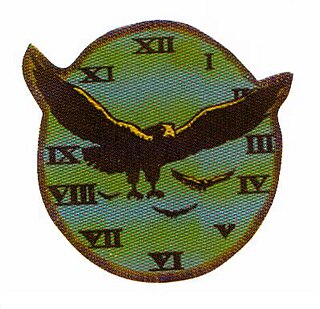
Marine Attack Squadron 543 (VMA-543) was an aviation unit of the United States Marine Corps. The squadron, also known as the "Night Hawks", were part of the Marine Forces Reserve and were based at Naval Air Station Glenview, Illinois until their deactivation on 1 April 1974. Originally activated during World War II, they fought in the Battle of Okinawa as part of the Tactical Air Force. The squadron was credited with downing 15 Japanese aircraft during the war. Following the surrender of Japan, the squadron was deactivated only to be later reactivated as part of the Reserves. They were again deactivated in 1974 and remain in an inactive status today.
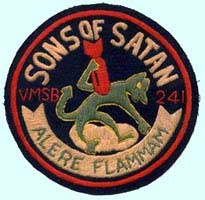
Marine Attack Squadron 241 (VMA-241) was an aircraft squadron of the United States Marine Corps, known as the "Sons of Satan". The squadron was commissioned during World War II and took part in the Battle of Midway, sustaining 75% losses. It was extensively involved in combat while providing close air support during the 1944–1945 Philippines Campaign. The squadron, equipped with A-4 Skyhawk light attack aircraft, became part of the Marine Forces Reserve, based at Naval Air Station Los Alamitos, California, from 1946 until the 1960s.

Marine Attack Squadron 324 (VMA-324) was an attack squadron in the United States Marine Corps. Nicknamed the "Devil Dogs," the squadron was based out of Marine Corps Air Station Beaufort, South Carolina for most of its history however it spent its last three years at Marine Corps Air Station Yuma, Arizona. Originally commissioned during World War II as a fighter squadron, VMF-324 deployed to Midway Atoll during the later months of the war never participating in combat operations. Following a post-war decommissioning, the squadron was reactivated during the Korean War as an attack squadron. VMA-324 conducted regular training evolutions and world-wide deployments until it was decommissioned on 29 August 1974.



















